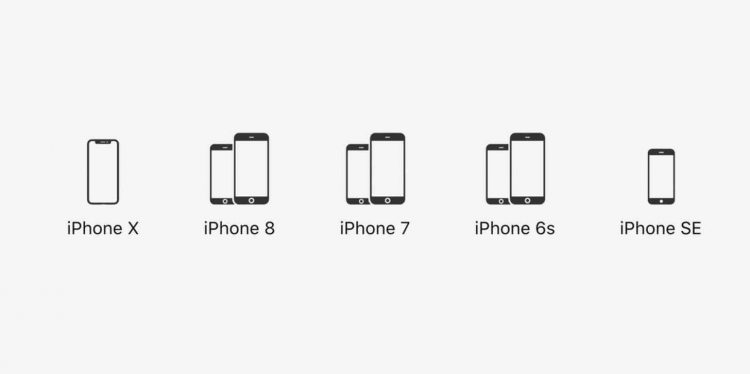The future of iPhone: An iPhone in every size?

Every few years since its inception, the design of Apple’s iPhone tends to go through some major changes. The first three iPhones are all similar to each other; the iPhone 4 brought sharper corners and glass backs; the iPhone 5 added an extra half-inch of screen; the iPhone 6 through the iPhone 8 brought a larger 4.7-inch display, along with their respective Plus variants with a 5.5-inch display; and finally, we get to the iPhone X, which brings a brand new bezel-less 5.8-inch display.
The interesting thing is that the iPhone 8, 8 Plus, and X were all new iPhone models announced together this year, yet they vary quite differently in how they’re designed. The 8 and 8 Plus look almost identical to the iPhone 7 and 7 Plus, give or a take a few details, and the iPhone X brings something else to the table entirely (for iPhones, at least). It’s out of the ordinary because normally when Apple releases a new generation of iPhones, they all sport a uniform design. It’s also the first year they released three new iPhones at the same time.
I’ve been thinking about what this means for the iPhone’s future. At first, I considered the iPhone 8’s release a stepping stone for those unhappy with the idea of a bezel-less display, or maybe an alternative for those who would rather have a cheaper option to the iPhone X’s base price tag of $999. Maybe both. By next year, I assumed that the X’s bezel-less design would be the design across the board. However, the more I think about it, the more I realize that it wouldn’t be too far-fetched for Apple to keep things this way, even if the iPhone 8 doesn’t necessarily look as jazzy as the iPhone X.
We have already witnessed how successful Apple can be regarding more “traditional” designs, with the iPhone SE as a prime example. The device’s specs may not be anything special anymore, but it remains unique for its size and surprisingly affordable price tag. The SE easily snagged users who still longed for a truly compact smartphone without crippling compromises, as well as new customers for Apple who may have been put off by the iPhone’s characteristically high price tags.
It’s easy to see why the SE has been a successful addition to Apple’s lineup. It’s also easy to see why the iPhone X is causing such a commotion, as it’s the most radical change to come to the iPhone yet, not to mention it’s exceptional specs. But between the conveniently compact size of the iPhone SE and the contemporary design of the iPhone X, is there really any room left for the iPhone 8 and 8 Plus to make a significant contribution?
Maybe not obviously, as it’s overshadowed by the iPhone X, but I think the iPhone 8 and 8 Plus are still worthwhile contenders.
Announcing the iPhone 8 and 8 Plus alongside the iPhone X is widely considered a “risky gamble” for Apple. Either people would appreciate the option, or they’d be put off by the fact that the iPhone 8 looks considerably dated next to the flashier iPhone X. Early numbers of iPhone 8 and 8 Plus orders suggest that the latter might be the case, but realistically it’s still too early to tell. People could be waiting en masse for the iPhone X, but if demand for the X exceeds supply, as it’s already expected to, then there’s likely to be an influx of orders for the iPhone 8 or 8 Plus as people resort to their “Plan B”.
Regardless, while the iPhone 8 and 8 Plus might not be the most popular iPhone this year, I still think they’re important and popular enough for Apple to keep around. I could easily see Apple keeping at least the 4.7-inch variant of the iPhone for a couple more years as a middle ground between the 4-inch and 5.8-inch iPhone sizes, as even a 4.7-inch device is a rare find these days aside from the iPhone. I’m not so sure about keeping the 5.5-inch Plus variant because that seems negligible next to a 5.8-inch display. I could also see Apple keeping the bezel-less design an exclusive to its most expensive iPhone, as not everybody is necessarily sold on the idea of bezel-less devices.
It seems a little silly to discuss the importance of a smartphone’s size, but since making the switch from the 5.5-inch Galaxy S7 Edge to the 4-inch iPhone SE, there are a lot of reasons to appreciate both, and I appreciate having the freedom to choose between them when I can.
I think having iPhones of varying sizes would be a good setup for Apple to keep. Android users have a cornucopia of devices to choose from that range in all sorts of shapes, sizes, and prices. iPhone users, on the other hand, must take what Apple gives them as the sole manufacturer of iOS products, so the more options Apple offers, the better (within reason). An offering of 4, 4.7, possibly 5.5 and 5.8-inch displays covers just about all the bases.
Readers, what are your thoughts? Do you hope Apple continues to offer a wider variety of iPhone sizes and variants from here on out?











